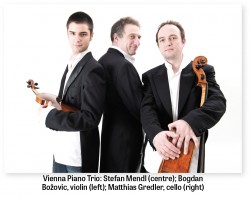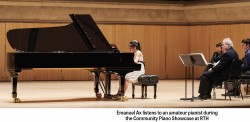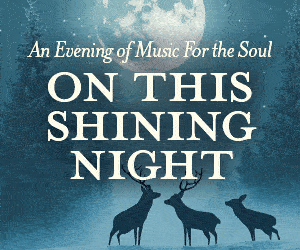 The Vienna Piano Trio’s previous Toronto appearances – with the Women’s Musical Club in November 2005 and three visits to Toronto Summer Music from 2010 to 2012 – were greeted with widespread acclaim. So it’s no surprise that they are highly anticipating their Mooredale Concerts recital March 8. That’s what the gregarious Stefan Mendl, the trio’s pianist and last remaining of its founding members, told me recently by phone from Vienna, the city where he has lived since his birth.
The Vienna Piano Trio’s previous Toronto appearances – with the Women’s Musical Club in November 2005 and three visits to Toronto Summer Music from 2010 to 2012 – were greeted with widespread acclaim. So it’s no surprise that they are highly anticipating their Mooredale Concerts recital March 8. That’s what the gregarious Stefan Mendl, the trio’s pianist and last remaining of its founding members, told me recently by phone from Vienna, the city where he has lived since his birth.
I asked him about the particular sensibility that typifies a chamber musician. “From scratch you must have the urge to find a special sound that is the group sound,” he answered. “You should not be so restrained that nobody can hear you but neither are you so predominant that you drown out the others. It must be your goal from the beginning that you find this sound; if you have a good ear and if you have the will to do this, then you are off to a good start.
“Then, of course there is experience, knowing when you can really play out and when you have to combine with the strings; when you have to give them more bass or less bass. You have to put aside your own ambitions and have the will to find a sound that blends.”
In his own case, right from his first experience on stage, chamber music felt better. “I discovered early on in my soloist days [born in 1966, he founded the trio in 1988] that I enjoyed playing concertos much more than recitals. I think that sometimes you get more ideas or better ideas when you have the chance to interact with others. At least for me that’s the case and I feel very, very comfortable with friends and with colleagues on stage. I don’t feel that comfortable when I’m on my own.
“And of course there is the wonderful music that is written for piano trio, piano quartet and piano quintet [he regularly performs with the Hagen Quartet]. Sometimes, all of our greatest composers put a lot of their inner feelings and emotions into their chamber music. I find it all very fascinating, still,” he said, with a laugh that underlined the hold the music still has on him.
The key thing to a trio’s success he believes is to have three people of equal musical and technical skill who have similar musical goals. “You need a rich palette of ideas and colour. Everybody needs their own opinion amidst the common goal.”
I wanted to know how he relates to the music the trio will be performing on the upcoming Sunday afternoon in Toronto. “Beethoven’s Kakadu Variations is really a fantastic piece of music,” he replied with palpable verve. “The very late opus number [Op.121a] is a bit misleading. No one hearing the very heavy introduction would expect it to turn into this funny theme, but there are hints, hidden in a minor key in a delicate, funny way. One slow variation before the finale is very deep and serious. Like all of Beethoven, the deepest and most serious is right next to the fun, almost grotesque or rude side. He was never shy, even in his greatest works to put little bits of his feelings right next to the really funny things. These variations are a really good way to experience that; in a very short amount of time he does all these turns and twists.”
This was a good opportunity to bring up the relationship between recording and live performance since the trio released the Kakadu variations along with Beethoven’s Trios Op.70, on their latest MDG Gold CD last year. “Recording something always affects your live playing because you get so close to it. You listen more to detail than you would otherwise ... sometimes you get things brought out that you probably wouldn’t have discovered before and then your performance is altered. Of course, your performance always changes over time,” he said.
Mendelssohn’s Trio No.1 Op.49 in D Minor, the concluding piece on the March 8 program, is the more famous of the composer’s two trios, but for Mendl, they are both on the same genius level. The trio plays them frequently and loves both of them. Mendl particularly enjoys the “gorgeous and brilliant and skillful piano writing which hardly any great composer has accomplished to that extent.
“It works so well for the medium of the piano trio because Mendelssohn had all these great melodies – mainly he wrote in the strings – and the texture for that is this incredibly bubbling piano part which makes a fantastic contrast. He does this in a very, very idiomatic way so that his piano trios will always be at the top of the list of the greatest trios both for performers and the audience. And a beautiful lyrical slow movement, a quicksilvery light scherzo – the type of scherzo so different from what anybody else wrote in those days ... The scherzo is perfect; there can’t be a more perfect scherzo imaginable.”
Mendl reminded me that Schumann had written a famous review raving about that D-Minor trio, calling it the role model of a piano trio. Very interesting in light of the preceding work on the Toronto recital, Schumann’s Fantasiestücke Op. 88. Despite its late opus number, it was written earlier than the composer’s piano trios but published later and less often performed. Schumann called them fantasy pieces because they didn’t conform to the trio form. The first and third pieces, the slow ones, are especially close to the pianist’s heart and “contain some of Schumann’s best piano trio writing ... they are in no way second rate.”
I was curious about the formidable list of mentors on the Vienna Piano Trio’s website, almost all of whom the trio met during a memorable two-week chamber music workshop in New York in 1993. “We’d never been to New York before so it was a double experience, really mind-blowing I would say, without exaggeration.” They got several lessons from Isaac Stern, the Guarneri Quartet (Arnold Steinhardt and Michael Tree), from Henry Meyer of the LaSalle Quartet and from the Kalichstein-Laredo-Robinson Trio. Mendl still remembers the kindness of Jaime Laredo who brought them back to New York for a concert series.
Most important was the enormous impact the intense workshop had on the group’s musical goals. It brought a “kind of down-to-earth quality” to what had been the “very polished style of trio playing we had experienced with [earlier mentors] the Trio di Trieste.”
Finally, I wondered, did living in Vienna inspire him, since the City of Dreams had been a place where many composers lived and died. “And died especially,” he laughed. “I personally live very, very close to where all these Beethoven memorial places are ... and although I don’t want to do this too consciously, sometimes I’m touched when I wander around in this area and I feel that Beethoven wrote so much music there and lived there for a great while.”
 Seen and Heard:The RBC Piano Extravaganza – or “Ax-travaganza” as Mervon Mehta dubbed it – took the city by storm over an 11-day period attracting approximately 14,000 to events at RTH alone. In addition, 27 amateurs performed on the hall’s newly acquired New York Steinway during the Community Piano Showcase; including the Young People’s Concert programs, 20 pianists performed on the RTH stage during the festival; and 200 people played the five Steinways in the festival’s inaugural event, Pianos in the City, February 4 between 11am and 2pm.
Seen and Heard:The RBC Piano Extravaganza – or “Ax-travaganza” as Mervon Mehta dubbed it – took the city by storm over an 11-day period attracting approximately 14,000 to events at RTH alone. In addition, 27 amateurs performed on the hall’s newly acquired New York Steinway during the Community Piano Showcase; including the Young People’s Concert programs, 20 pianists performed on the RTH stage during the festival; and 200 people played the five Steinways in the festival’s inaugural event, Pianos in the City, February 4 between 11am and 2pm.
My immersion in the Extravaganza began on its second day, Thursday February 5, with festival curator Emanuel Ax’s introduction of two young pianists at a COC free noontime concert. Siberian-born Pavel Kolesnikov, the 2012 Honens Competition winner now studying with Maria João Pires in Brussels, learned three Liszt transcriptions of Wagner operas, including the “Pilgrim’s Chorus” from Tannhäuser, especially for the event. Impressive. American pianist Orion Weiss, who left his native Cleveland for Juilliard, specifically to study with Ax for his integrity and revelatory playing, brought a singing touch to a pair of Granados Goyescas. Several hours later they played a dynamically well-matched Rachmaninoff Symphonic Dances for two pianos that preceded a TSO concert that included the orchestral version of the same piece.
Ax began that program with an agreeable, self-effacing rendition of a Schubert impromptu followed by Mozart’s Piano Concert No. 14 K449. Round tones of limpid liquidity gave the impression that the pianist was opening a musical jewel box.
The four-hour and twenty-minute Pianopalooza Sunday afternoon included 16 disparate performers selected by the RCM in a musical cavalcade that came close to filling Koerner Hall and concluded with a show-stopping, two-piano-eight-hands version of Tchaikovsky’s 1812 Overture complete with recorded cannon shots. The event featured two bona fide highlights: Robi Botos’ jazz set was an uninterrupted 20-minute piece of spontaneous joy; Ax’s melodic, technically assured performance of Chopin’s Scherzo No. 2 was piano playing at its best.
Three days later, Ax joined Jan Lisiecki for Mozart’s heavenly Concerto for Two Pianos K316a/365 and Saint-Saëns’ delightfully entertaining The Carnival of the Animals.
The next day in a pre-concert performance, Ax displayed his chamber music skill set in an immensely satisfying reading of Schumann’s Piano Quintet Op. 44. The string parts were taken by the first chair TSO players, concertmaster Jonathan Crow, principal second violinist Paul Mayer, prinicipal violist Teng Li and principal cellist Joseph Johnson. The players faced the choir loft, which overflowed into the adjacent sections of the hall. No one who heard them will forget the strings’ strength, the way Ax was able to emerge from the background to point out the melody and the assured playing of this propitious gathering.
Later that evening Ax demonstrated a deft curatorial touch in an adventurous program pairing a two-piano piece with its orchestral equivalent. Ax and Stewart Goodyear, more or less balanced in selected pieces of Carl Maria von Weber, returned for an exciting performance of Ravel’s La Valse. In between Anagnoson & Kinton proved to be very well-matched in an apparently seamless gambol through Brahms’ Variations on a Theme by Haydn. As in the previous week’s Rachmaninoff Symphonic Dances, the orchestral colour was more varied than the keyboards’ but the unique opportunity to hear the difference was welcome.
Ax spoke of his love of the word “metamorphosis” when he introduced that program. The next morning he became its agent at a master class for Glenn Gould School students. He was his usual combination of self-effacing and endearing as his analysis and advice transformed a student’s performance of Chopin’s Barcarolle, a piece he called “ecstatic” and which he linked forward to Wagner and back to Bach. He continued his delicate balance of dispensing compliments, ever careful that his suggestions would not be construed as outright criticism.
He recalled an encounter he had as a young man with Pablo Casals when the cellist was 96 and spending his last summer at Marlboro. “[When] the music goes up, [play] loud; music goes down, soft,” Casals instructed. “We all thought he was out to lunch,” Ax said. “But the older I get, the more I see how right he was.”
Quick Picks:
Mar 6 Siberian-born violinist Vadim Repin, the interview subject of my last month’s column, makes his eagerly awaited Toronto recital debut at Koerner Hall in a diverse program of Bartók, Debussy, Ravel, Stravinsky and Tchaikovsky.
Mar 8 at Koerner Hall KahaneSwensonBey, who re-formed in 2012 after a 25-year hiatus, perform piano trios by Mozart, Schumann, Ravel and Schoenfield. In an unfortunate scheduling conflict their afternoon concert occurs at the same time as the Vienna Piano Trio’s Mooredale recital in Walter Hall just minutes away.
On the evening of Mar 8 violinist Moshe Hammer and pianist Angela Park perform works by Brahms, Franck and Sarasate at the Aurora Cultural Centre.
Mar 11, 12 and 14 Gianandrea Noseda conducts the TSO in a program featuring Beethoven’s Symphony No. 7, which is all you need to know to make plans to attend. The program also includes Adrianne Pieczonka performing Wagner’s Liebestod from Tristan und Isolde and Richard Strauss’ divine Four Last Songs, which further certifies it as a must-see. Rising star Krzysztof Urbanski and the TSO are joined Mar 27 and 28 by the captivating Sol Gabetta in Dvořák’s masterpiece, his Cello Concerto in B minor, Op. 104, a work they have played together many times. Then Urbanski leads the orchestra in Stravinsky’s rhythmic revelry, The Rite of Spring. Another must-see.
TSO associate principal clarinetist Yao Guang Zhai is joined by pianist Jeanie Chung for Luigi Bassi’s Concert Fantasy on themes from Verdi’s Rigoletto in a free COC concert also featuring Gershwin, Brahms and three solo pieces by Stravinsky at the Richard Bradshaw Amphitheatre Mar 12.
Mar 14 is crystal ball gazing time when students from the Phil and Eli Taylor Performance Academy for Young Artists give a free concert in Mazzoleni Hall. On Mar 31 another Mazzoleni Hall free concert (ticket required) features solo and chamber works performed by Rebanks Fellows from the Glenn Gould School. Apr 2 three of the Rebanks Fellows perform Brahms’ gorgeous Trio for horn, violin and piano in a free noontime COC concert.
Mar 15 Trio Arkel with guests, cellist Amanda Forsyth and violinist Aaron Schwebel, perform Schubert’s sublime String Quintet in C in the Church of the Holy Trinity.
Mar 16 group of 27 presents Payadora Tango Ensemble and g27 violinist Rebekah Wolkstein in a recital at Heliconian Hall.
Don’t miss your chance Mar 19 to hear the Elias String Quartet, the “excellent” (New York Times), “exuberant” (The Guardian) young British ensemble making their local debut presented by Music Toronto, in works by Haydn, Mozart and Mendelssohn.
Mar 22 Alliance Française presents Stravinsky’s tuneful fable The Soldier’s Tale featuring Jacques Israelievich, violin, with Uri Mayer conducting.
Mar 27 Violinist Lisa Batiashvili, Till Fellner’s trio partner (along with Alfred Brendel’s son Adrian) is joined by pianist Paul Lewis in his first Toronto appearance since his remarkable debut opening the Women’s Musical Club’s 115th season in the fall of 2012. Their program includes Schubert’s “Grand Duo” and “Rondeau brilliant,” Beethoven’s Violin Sonata No.10, Op.96, Telemann’s Fantasia No.4 for Solo Violin and Busoni’s arrangement of Bach’s Chorale Prelude “Nun komm’ der Heiden Helland” for solo piano.
Mar 27 and 28 the incomparable Kitchener-Waterloo Chamber Music Society presents concerts 13, 14, 15 and 16 in the Attacca Quartet’s ongoing series performing all 68 of Haydn’s quartets. Each concert features quartets drawn from the early, middle and later period of the composer’s life.
YouTube star Valentina Lisitsa’s piano playing has struck quite a few chords based on upwards of 80 million views. Before her Royal Albert Hall recital in front of an audience of 8000 in June 2012 her fans had the chance to vote online for their preferred program – a form of audience participation that has become one of Lisitsa’s trademarks. Will the contents of her BravoNiagara! solo concert Apr 4 be similarly chosen?
Paul Ennis is the managing editor of The WholeNote.



